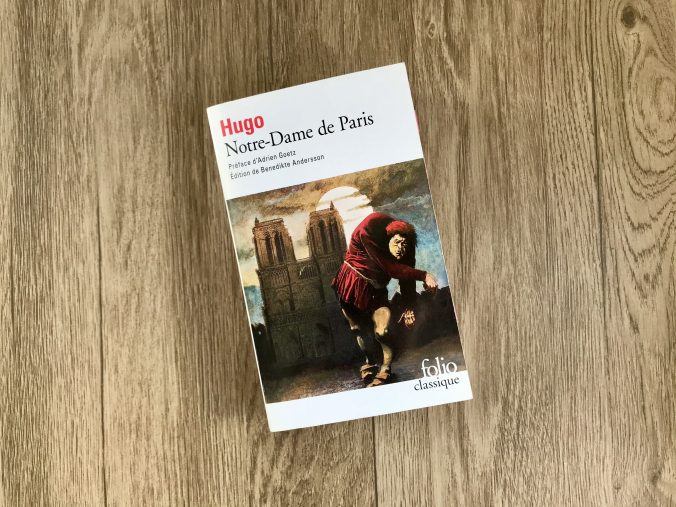[SCROLL DOWN FOR THE ENGLISH VERSION]
Notre-Dame de Paris (Estação Liberdade, 584 páginas), de Victor Hugo, é um clássico da literatura que eternizou não só a cidade de Paris, mas também a icônica catedral francesa, certamente uma das mais conhecidas no mundo.
Comprei o livro, um tanto por impulso, em 2018, depois de fazer o passeio turístico que levava ao topo da catedral e cujo percurso trazia várias referências ao romance de Hugo, especialmente no local onde ficavam os sinos. Já havia visitado a catedral em outras oportunidades, mas nunca tinha subido as escadarias. Sem dúvida, foi uma das vistas mais impressionantes que já tive de Paris. Alguns meses depois, em abril, boa parte do que eu vira ruiria no dramático incêndio que tomou conta da catedral e chocou o mundo todo.
Ler o romance de Victor Hugo foi, então, uma forma de reviver as belezas que eu havia visto naquela tarde de outono. Descrições minuciosas da cidade e, especialmente, da catedral, são parte importante da obra. Quem já leu outros livros do autor francês, como Os Miseráveis, está habituado a esse estilo, característico do romantismo francês. A proposta do movimento era revisitar o passado a partir de um enredo ficcional, guardando, no entanto, o estilo realista na descrição de lugares e grandes marcos históricos.
Paris é um magnífico e encantador espetáculo; e a Paris de então também era, sobretudo vista do alto das torres da Notre-Dame, a fresca claridade de uma aurora de verão.
No entanto, não é só de paisagens emblemáticas que essa obra de Hugo é composta. Como uma boa novela romântica, não faltam personagens apaixonantes e reviravoltas cheias de drama.
Impossível ler esse romance e não sofrer com as desventuras de Quasimodo, se inquietar pelas decisões erradas de Esmeralda, se enfurecer com a falta de caráter de Phoebus e se chocar com a crueldade de Frollo. Em uma crítica clara à sociedade de então, Quasimodo consegue ter mais empatia e senso de justiça que a maioria dos outros personagens do livro, apesar de todo ódio e preconceito que o cercaram desde criança, por conta de sua aparência física:
A palavra humana para ele era sempre uma ralharia ou uma maldição. Crescendo, encontrara apenas a raiva ao seu redor.
Outro aspecto que chama bastante atenção é a relação do personagem central, Quasimodo, com a catedral e seus elementos – os sinos, as gárgulas e cada pedra da construção. A igreja é seu lar e o mais próximo que ele chegou de um sentimento de acolhimento. Em vários momentos da leitura, ficamos com a impressão de que a catedral e Quasimodo são um único personagem, com expressões e emoções que se completam:
A tal ponto que, para que aqueles que sabem que Quasimodo existiu, Notre-Dame é hoje deserta, inanimada, morta. Sente-se que algo desapareceu. Esse corpo imenso está vazio, e é um esqueleto, o espírito o deixou; vê-se apenas o lugar, eis tudo. É como um crânio onde há ainda as cavidades dos olhos, porém não mais o olhar.
Notre-Dame de Paris é um clássico que exige atenção e paciência, pois, em certos trechos, as longas e minuciosas descrições comprometem a fluidez da leitura. No entanto, o esforço definitivamente vale a pena! Afinal, a beleza da escrita de Hugo e seu talento para longas narrativas são incontestáveis.
The Hunchback of Notre Dame, by Victor Hugo, is a classic of literature that has immortalized not only the city of Paris, but also the iconic French cathedral, certainly one of the world’s most visited religious monuments.
I bought the book in 2018. It was an impulse buy after taking the tour that led to the roof of the cathedral, where there were a lot of references to Hugo’s novel. I had already visited the cathedral once, but I had never gone upstairs before. It was definitely one of the most impressive views I have ever had over Paris. A few months later, in April, much of what I had seen would burn in the dramatic fire that damaged the cathedral and shocked the whole world.
Reading Victor Hugo’s novel was a way to bring back happy memories from that autumn afternoon. Detailed descriptions of the city, and especially the cathedral, are an important part of the novel. Anyone who has read other books by the French author, such as Les Misérables, is used to this style, characteristic of French romanticism. The movement revisits the past from a fictional plot, keeping, however, the realistic style in describing places and great historical landmarks:
Paris is a magnificent and charming spectacle, and especially, at that day, viewed from the top of the towers of Notre-Dame, in the fresh light of a summer dawn.
However, this work by Hugo covers much more than only emblematic landscapes. Like most romantic novels, it features plenty of passionate characters and dramatic plot twists.
It is very likely to read it through and to suffer from Quasimodo’s misfortunes, to worry about Esmeralda’s wrong decisions, to be furious about Phoebus’s lack of character, and to be shocked by Frollo’s cruelty. In a clear critique of society then, Quasimodo demonstrates more empathy and sense of justice than most of the other characters in the book, despite all the hatred and prejudice that has surrounded him since he was a child, mainly due to his physical appearance:
Human speech had never been to him aught but a jeer or a curse. As he grew up, he had found nothing but hatred about him.
Another aspect that draws attention is Quasimodo’s bond with Notre-Dame – each stone, the bells, and the gargoyles. The church is his home and the closest he came to a feeling of welcome. At various moments, we feel like the cathedral and Quasimodo are a single character, as they share emotions and moods:
To such a point was he so, that to those who knew that Quasimodo once existed Notre-Dame now appears deserted, inanimate, dead. You feel that there is something wanting. This immense body is void; this is a skeleton: the spirit has departed; you see its place, and that is all. This is like a skull: the sockets of the eyes are still there, but the eyes themselves are gone.
Notre-Dame de Paris is a classic that requires attention and patience, for it has long and detailed descriptions, which may slow your reading. However, it is definitely worth the effort! After all, Hugo’s brilliant writing and his talent for long narratives are undeniable.
Mariane Domingos
Últimos posts por Mariane Domingos (exibir todos)
- [Resenha / Review] A Vida Pela Frente / The Life Before Us - 14 de março de 2021
- [Resenha / Review] The Vanishing Half - 15 de fevereiro de 2021
- [Resenha / Review] Garota, Mulher, Outras / Girl, Woman, Other - 4 de janeiro de 2021


![[English ⬇️] “Estes são, acima de tudo, ensaios pessoais: pequenos por definição, curtos por necessidade”. “Intimations” é uma coletânea de ensaios de Zadie Smith escrita durante os primeiros meses de isolamento. Nem preciso dizer que essa leitura é extremamente reflexiva e tocante, certo? Tenho certeza – assim como Smith também tem, segundo o que ela mesma esclarece no prefácio – que ainda há muito a ser escrito sobre esta crise sem precedentes para nossa geração. Mas isso não muda o fato de que vale muito a pena ler este livro, especialmente se você não quer esperar mais para dar ao menos um pouco de sentido ao caos. Embora este livro não pretenda explicar nada, ele acaba fazendo isso porque Smith é incrivelmente habilidosa com as palavras. Ela consegue nomear os sentimentos que dominaram o mundo desde o ano passado, apenas observando atentamente o que a cerca e colocando suas impressões em palavras. Da tendência do bolo de banana à consciência do privilégio de classe e a reflexões sobre o assassinato de George Floyd, Smith apresenta histórias curtas com as quais você certamente se identificará, já que todos nós temos vivenciado essa terrível experiência da pandemia.](http://www.achadoselidos.com.br/wp-content/plugins/instagram-feed/img/placeholder.png)
Deixe uma resposta